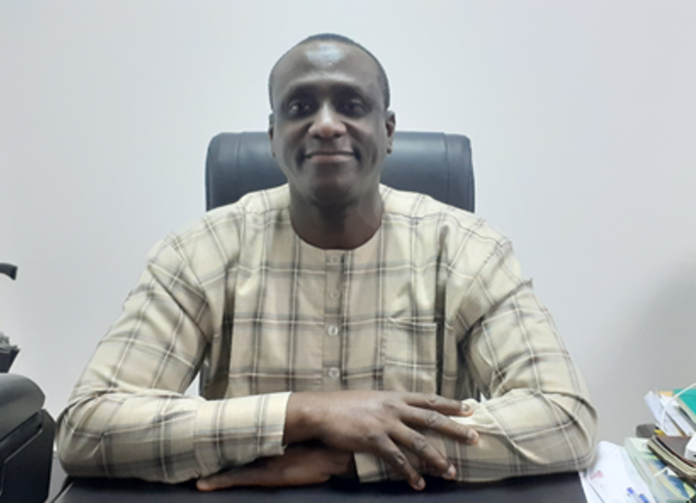By Momodou Jarju
Notable eye specialist in The Gambia has unfilled the prevalence rate of glaucoma, an eye disease associated with increasing age and often associated with high eye pressure, in West Africa, which The Gambia is no exception.
In an exclusive interview with Foroyaa recently, Dr. Abba Hydara, the Chief Executive Officer for Sheikh Zayed Regional Eye Care Centre, disclosed that glaucoma’s prevalence in our sub-region is the highest globally.
“In some areas it is as high as 19%; that is one in five almost. One in five adults will have glaucoma,” said Dr. Hydara, who is also a Senior Consultant Ophthalmic Surgeon and the Coordinator for National Eye Health Programme of the Ministry of Health.
Blindness due to glaucoma is irreversible. And the aforesaid eye disease is the leading cause of irreversible blindness globally.
Emphasizing on the disease being commonest in the sub-region, Dr. Hydara said the causative gene could probably be in West Africa.
Asked how common glaucoma is in The Gambia, the eye specialist said it used to be the third leading cause of blindness.
The current statistics on the causes of blindness in the country will soon be ascertained as a survey to that effect has already been conducted last year, in 2019, and the results are being studied with its publication in the offing.
“In the developed world, more than 50% of the people are unaware that they have glaucoma, but in Africa, more than 90% of the people are unaware that they have glaucoma,” he said.
Answering why the higher proportion in Africa, Dr. Hydara said because as long as they (Africans) can see straight ahead, they think they are fine. Glaucoma damages the peripheral visual fields first so most people are unaware as they slowly lose their visual fields.
He also emphasized that early glaucoma is asymptomatic. Glaucoma is called “the silent thief of sight” and it usually takes over 60% of optic nerve damage for symptoms to develop.
“So glaucoma has a very strong genetic component. Every human being has some risk of developing glaucoma. As age increases, one’s risk of glaucoma also increases. For every 10 years that risk sort of doubles,” he added.
Speaking further, Dr. Hydara said if a person’s relative has glaucoma, then the person is 10 times more likely to also have it. This is due to the strong genetic component associated with the disease.
“So if your first degree relative has glaucoma, you are 10 times more likely to have it. In fact, it’s almost absolute that you will have it. So we can say, you are 99% sure that once your close relative has it, you will also have it because of the closeness of the genes that are responsible,” he said.
Important Statistics
According to ScienceDirect, an interdisciplinary research institution which says in its website that it “helps academic institutions and government organizations go beyond search to discover new breakthroughs”, the global prevalence of glaucoma for population aged 40–80 years is 3.54% (95% CrI-credible interval, 2.09–5.82).
This information is contained in an article titled “Global Prevalence of Glaucoma and Projections of Glaucoma Burden through 2040: A Systematic Review and Meta-Analysis.”
The article revealed that the prevalence of POAG (primary open-angle glaucoma) is highest in Africa (4.20%; 95% CrI, 2.08–7.35), and the prevalence of PACG (primary angle-closure glaucoma) is highest in Asia (1.09%; 95% CrI, 0.43–2.32).
It also says in 2013, the number of people (aged 40–80 years) with glaucoma worldwide was estimated to be 64.3 million, increasing to 76.0 million in 2020 and 111.8 million in 2040.
These estimates are important in guiding the designs of glaucoma screening, treatment, and related public health strategies, the article revealed.
The information contained in the article was based on data from 50 population-based studies (3770 POAG cases among 140 496 examined individuals and 786 PACG cases among 112 398 examined individuals). And PubMed, Medline, and Web of Science for population-based studies of glaucoma prevalence published up to March 25, 2013 were searched.
What More Is Glaucoma?
Unlike cataract which affects vision immediately as it develops, glaucoma doesn’t quickly affect vision. But when it sets in, it can lead to irreversible blindness.
Dr. Hdyara explained that glaucoma is a disease of the optic nerve- these are nerves that are responsible for connecting the eye to the brain.
He said when someone gets glaucoma, some of those specific nerve fibres and cells become sensitive to either the blood supply or the pressure inside the eye for some unusual reason and they selectively die.
The process of “selective cell death” or “programmed cell death” is called apoptosis.
The Gambian eye specialist further said as the nerve fibres and cells die, the individual is initially unaware, thus they start losing peripheral vision and ultimately they can lose all their vision.
“So glaucoma is a slowly developing disease. It’s insidious. It doesn’t happen suddenly. It is slowly destroying and taking the sight. So the Americans call it “the silent thief of sight” because it silently comes and steals your vision while you are not aware,” he said.
“If one is blind from glaucoma, nothing can be done about it. You will never recover that vision…So glaucoma is important and we need to raise awareness about it, because if it is not detected early, if close relatives do not come forward to have their eyes tested, by the time they realise they have glaucoma it may be too late.”
Signs and Symptoms
Initially, there are no symptoms for glaucoma, according to Dr. Hydara. He said the person is unaware and would not complain of anything.
The person would be seeing like everyone else, unless he/she is checked for the risk factors by an eye specialist, they would think they have no problem.
“So when the disease is early, there are no symptoms. When the disease is advanced, then the vision is poor. They start bumping into objects, you get up, you want to go there, you hit that chair because you lose peripheral vision, you don’t see,” he said.
So bumping into the objects, he said, could be one of the earliest signs. He went on to say that in the evenings, when it is beginning to get dark, vision tend to get worse. And that the bright vehicle headlight in the evenings will tend to disturb them.
“So that’s the beginning and then later on they lose peripheral vision they could only see through a narrow area which is called “tunnel vision”. So these are the early symptoms and like I said whatever is lost in glaucoma cannot be brought back,” he said.
Managing Treatment
Sadly, when one has glaucoma and it is diagnosed early, it can be managed but it cannot be cured.
Dr. Hydara said eye specialists can intervene and bring the pressure in the eye(s) down, saying for every millimeter the pressure is reduced it is preventing that person from going blind by 10%.
This, he said, was evidence from a major study called the Early Manifest Glaucoma Treatment study.
“So if you identify someone with glaucoma, if you do something to bring their pressure down, you slow down their rate of going blind. So if they were supposed to go blind in two years, if you intervene and start them on treatment and the treatment is effective, they probably will not go blind after five years or more,” he explained.
Dr. Hydara emphasized that intervening early with early diagnosis and early treatment can prevent irreversible damage.
“So people need to be aware of this so that they can come and have their eyes tested. You test the vision but we test the eye pressure because pressure is the only variable we can maneuver; we can play with, we can bring {it} down in order to prevent blindness. And then if they come to the hospital regularly, we can monitor how they are responding to treatment. But also, if the disease is stable or it is progressing; so that more intervention can be made to prevent blindness. So it is critical that people are aware,” he said.
However, Dr. Hydara noted that the challenge is whether people are willing to take the treatment properly. He also asked whether people are willing to invest in their own health and to be responsible for their own health.
To him, every Gambian and African above the age of 30-35 should have their eyes checked for glaucoma, while pointing out that most of the people in America who had glaucoma and they didn’t know are the ones involved in most motor vehicle accidents and most litigation because of driving negligence and the like.
Government’s Effort
Dr. Hydara-led eye-care treatment center, Sheikh Zayed, is the face of the Gambia Government’s specialist tertiary institution. Policy wise, Dr. Hydara said they are training people to be able to diagnose the condition early.
“So we train for early diagnosis and referral so that they can be managed properly.”
But also, Hydara noted that the Government occasionally buys eye drops that help to reduce the eye pressure, adding that of all the risk factors associated with glaucoma, eye pressure is the only one they can change (modifiable factor).
Not wanting the eye pressure to be elevated, special eye drops are given to the patient. The eye specialist said most of the eye drops are very expensive and they are not readily available, plus government cannot buy them. However, he said some can be procured cheaply which can help reduce the pressure.
“So we train people to identify some of these risk factors. Initiate treatment and refer the patient for proper management,” he added.





















